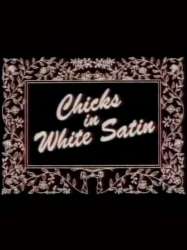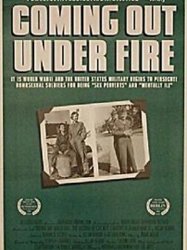Les films ayant le thème "Documentaire sur l'homosexualité", triés par recette

Tongues Untied (1989)
, 55minutesRéalisé par Marlon Riggs
Origine Etats-Unis
Genres Documentaire
Thèmes Maladie, Sexualité, Homosexualité, Documentaire sur l'homosexualité, Documentaire sur la santé, LGBT, Sida, LGBT
Acteurs Marlon Riggs, Michael Bell, Eddie Murphy
 , 1h
, 1hRéalisé par Rosa von Praunheim
Genres Documentaire
Thèmes Maladie, Sexualité, Homosexualité, Documentaire sur l'homosexualité, Documentaire sur la santé, LGBT, Sida, LGBT
Acteurs Larry Kramer, Rosa von Praunheim, Ronald Reagan
 , 1h
, 1hRéalisé par Rosa von Praunheim
Origine Etats-Unis
Genres Documentaire
Thèmes Maladie, Sexualité, Homosexualité, Documentaire sur l'homosexualité, Documentaire sur la santé, Documentaire sur les villes, LGBT, Sida, LGBT
Acteurs Paul L. Smith, Rosa von Praunheim
This film explores the reactions and response of New York City's artistic community to the ravages of the AIDS epidemic and other issues of homosexuality. Activist interview include representatives from the many arts organizations that have alerted the public to the crisis through performance art, music, theater and literature. Even with the gentler voices, the film’s undercurrent is an angry demand for action and recognition.
 , 1h17
, 1h17Origine Etats-Unis
Genres Documentaire
Thèmes Maladie, Sexualité, Homosexualité, Documentaire sur l'homosexualité, Documentaire sur une personnalité, Documentaire sur la santé, Folie, LGBT, LGBT
Acteurs Patrick Stewart

Ladyboys (1992)
Réalisé par Charles Herman-Wurmfeld
Genres Documentaire
Thèmes Sexualité, Homosexualité, Transsexuels et transgenres, Documentaire sur l'homosexualité, LGBT, LGBT

Nitrate Kisses (1992)
, 1h7Réalisé par Barbara Hammer
Origine Etats-Unis
Genres Documentaire
Thèmes Sexualité, Homosexualité, Documentaire sur l'homosexualité, LGBT, LGBT, Lesbianisme

Greetings from Out Here (1993)
Réalisé par Ellen Spiro
Thèmes Sexualité, Transport, Homosexualité, Documentaire sur l'homosexualité, Road movie, LGBT, LGBT
On her journey, filmmaker Ellen Spiro visits memorable landmarks, events and characters, including Mardi Gras, Gay Pride in Atlanta, the Gay rodeo, Dollywood, Miss Miller's Eternal Love and Care Pet Cemetery, and the Short Mountain Radical Faerie sanctuary.
 , 55minutes
, 55minutesOrigine Etats-Unis
Genres Documentaire
Thèmes L'enfance, Maladie, Sexualité, Homosexualité, La pédophilie, Documentaire sur le droit, Documentaire sur l'homosexualité, Documentaire sur une personnalité, Documentaire sur la santé, Documentaire sur la maltraitance des enfants, Folie, Le handicap, Maltraitance des enfants, LGBT, LGBT
The film describes the organization and its history. It presents a series of interviews with NAMBLA members who describe their feelings towards boys and justifications for such feelings.

Chicks in White Satin (1994)
, 25minutesOrigine Etats-Unis
Genres Documentaire
Thèmes Religion, Sexualité, Homosexualité, Documentaire sur l'homosexualité, Documentaire sur une personnalité, Documentaire sur la religion, Religion juive, LGBT, LGBT et la religion, LGBT, Lesbianisme

Coming Out Under Fire (1994)
, 1h11Réalisé par Arthur Dong
Origine Etats-Unis
Genres Guerre, Documentaire
Thèmes Sexualité, Homosexualité, Documentaire sur la guerre, Documentaire historique, Documentaire sur l'homosexualité, Politique, Documentaire sur la Seconde Guerre mondiale, LGBT, LGBT
Acteurs Salome Jens

Andělé nejsou andělé (1994)
, 1h20Genres Documentaire
Thèmes Sexualité, Erotique, Homosexualité, Prostitution, Documentaire sur l'homosexualité, Documentaire sur la prostitution, LGBT, LGBT

Straight from the Heart (1994)
, 24minutesOrigine Etats-Unis
Genres Documentaire
Thèmes La famille, Religion, Sexualité, Homosexualité, Documentaire sur l'homosexualité, Documentaire sur une personnalité, LGBT, LGBT
Acteurs Bob Paris
 , 1h25
, 1h25Réalisé par Aerlyn Weissman, Lynne Fernie
Origine Canada
Genres Documentaire, Historique
Thèmes Film sur un écrivain, Sexualité, Homosexualité, Documentaire sur l'homosexualité, Documentaire sur une personnalité, LGBT, LGBT, Lesbianisme
Acteurs Stéphanie Morgenstern, Lynne Adams, Marie-Jo Thério, Ann-Marie MacDonald
Dix femmes, vivant pour la plupart à Vancouver ou à Toronto, parlent de leur vie de lesbienne dans les années 1940, 1950 et 1960 : elles découvrent les romans en fascicules de l'époque sur les femmes amoureuses, leurs premières aventures, la douleur de la rupture, la fréquentation des bars gays, les descentes de police, les réactions des hommes et l'étiquette des rôles masculins et féminins. Les interviews et les images d'archives sont entrecoupées de quatre chapitres dramatisés d'un roman de gare, "Forbidden Love" : Laura quitte son bled pour la ville, où elle rencontre Mitch dans un bar. Les étincelles fusent, les rires et la joie aussi. Ann Bannon, l'un des auteurs de ces romans de poche sur l'amour interdit, parle du genre.

Shinjuku Boys (1995)
, 53minutesRéalisé par Kim Longinotto
Origine Royaume-uni
Genres Documentaire
Thèmes Sexualité, Homosexualité, Transsexuels et transgenres, Documentaire sur l'homosexualité, LGBT, LGBT

Wigstock: The Movie (1995)
, 1h25Origine Etats-Unis
Genres Documentaire, Musical
Thèmes Sexualité, Homosexualité, Transsexuels et transgenres, Documentaire sur l'homosexualité, Musique, LGBT, LGBT, Travestissement au cinéma
Acteurs Debbie Harry, Leigh Bowery, Candis Cayne, Miss Coco Peru, RuPaul, Alexis Arquette
 Connexion
Connexion